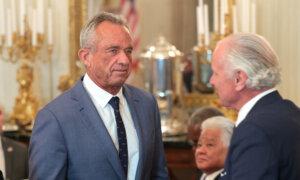Robert F. Kennedy Jr., secretary of the Department of Health and Human Services (HHS), on March 27 announced major changes at HHS, including the merging of some divisions, in a bid to become more efficient.
The other goal is to improve the quality of service.
Kennedy said that, in addition to consolidating divisions, mass layoffs would reduce the full-time HHS workforce by about 25 percent from 82,000 workers.
Kennedy said the transition will be painful but that the department is “going to do more with less.”
The reorganization, which will take 28 divisions down to 15, is expected to save $1.8 billion per year, according to health officials.
The division that will be most affected is the Food and Drug Administration, with about 3,500 workers being fired, according to HHS. The Centers for Disease Control and Prevention’s workforce will be reduced by about 2,400 employees. Some 1,200 employees at the National Institutes of Health will no longer have jobs. The Centers for Medicare and Medicaid Services, another division, will move forward with about 300 fewer workers.
HHS said in a statement that many of the divisions contain “redundant units.” Officials are going to consolidate the units into 15 divisions. One new division, the Administration for a Healthy America, will feature five former divisions, including the Health Resources and Services Administration and the Substance Abuse and Mental Health Services Administration.
The Administration for Strategic Preparedness and Response, which is responsible for responding to public health emergencies and national disasters, will be folded into the Centers for Disease Control and Prevention.
The Office of the Assistant Secretary for Planning and Evaluation will merge with the Agency for Healthcare Research and Quality to form the Office of Strategy, with a focus on enhancing research “that informs the Secretary’s policies and improves the effectiveness of federal health programs,” according to HHS.
Work currently carried out by the Administration for Community Living, which helps older people and individuals with disabilities, will be redistributed to other agencies, including the Centers for Medicare and Medicaid Services.
The agency’s regional offices will also be reduced from 10 to five. The HHS Office of General Counsel previously stated that it was closing six of its 10 regional offices.
Some criticized the announcement.
“I have serious concerns about how this will impact Americans’ well-being now and long into the future,” he wrote.
National Treasury Employees Union President Doreen Greenwald said the cuts would have a devastating effect on public health services across the country.
Others expressed cautious optimism.
Other workers accepted the Trump administration’s buyout offer, which let workers go on paid leave until September 2025 or take early retirement, HHS stated on March 27.
About 10,000 additional employees will be terminated, according to the department. Once complete, the restructuring will leave HHS with a workforce of about 62,000.
The HHS budget increased by about 38 percent from 2021 to 2025, Kennedy said, while staffing went up by 17 percent during that time.
“But all that money has failed to improve the health of Americans,” he said.
Kennedy cited the growth in the rate of chronic disease and cancer, as well as a lower life expectancy for Americans when compared with Europeans.
Kennedy said he has found that HHS is “mainly operating in silos,” with some divisions working “at cross-purposes with each other.”
“A few isolated divisions are neglecting public health altogether and seem only accountable to the industries that they’re supposed to be regulating,” Kennedy said, without naming the divisions.
He also said that, in one instance, “defiant bureaucrats impeded the secretary’s office from accessing the closely guarded databases that might reveal the dangers of certain drugs and medical interventions.”
HHS did not respond to requests for more information.






